
Mr Palitoy's Cardback Guide |
 |
The
first Palitoy catalogues with Star Wars merchandise in them were
produced by Palitoy in 1978 when they launched the Star Wars range of
toys. These catalogues were used by salesmen to sell toys in bulk to toy
dealers. These are fairly rare and quite collectable, as a lot of them
feature prototypes and Kenner toy versions in the artwork that were not
seen in the finished line of toys. The main catalogue had the toys
displayed in them along with a catalogue number, the quantity of the toy
in the sales pack and a brief description of the toy. A separate price
list with the same cover was also produced which gave the retail price
that the toys were sold to toy dealers at. These toy dealers would then
sell them on with a mark up. The 1978 catalogue
for the Retail Sales Division features a cover which has stars in space
on it with the Palitoy logo in the bottom right hand corner with Retail
Sales Division written underneath and the the year 1978 above. The
price list has the same cover on it but is narrower and has prices for
the toys in the main catalogue.   On
the first page featuring Star Wars are the first 12 action figures with
major differences visible on Death Squad Commander and the Tusken
Raider. Ben Kenobi, Luke Skywalker and Darth Vader all have double
telescoping light sabers which were produced on early Kenner versions of
the figures, but never for Palitoy. The second page shows the 12 inch
Luke SkyWalker and Princess Leia figures which were the only 2 Large
Size Action Figures produced by Palitoy. The inflatable light saber is
show next to these 2 figures. 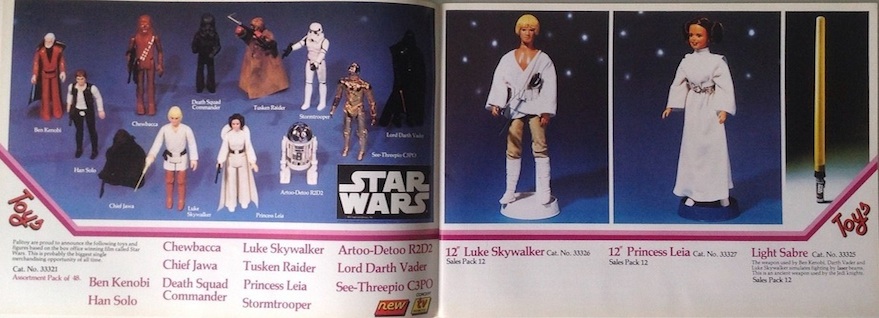 The
third page shows vehicles and spaceships from the launch range. The Tie
Fighter, Land Speeder and X-Wing Fighter pictured are all prototypes
that look significantly different from the finished Palitoy or Kenner
versions of the toys.  The
last pages featuring Star Wars is a double page featuring the Destroy
Death Star Game which was board game unique to Palitoy rather than being
licensed from Kenner.  The
main catalogue for the General Sales Division has the same cover as the
catalogue for the Retail Sales Division with the word General replacing
Retail. The price list for the General Sales Division has the same
cover as the price list for the Retail Sales Division with the word
General replacing Retail. 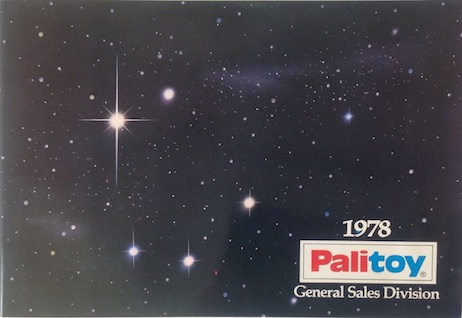  There
are 4 pages which feature Star Wars toys in this catalogue. The first
page features Play-Doh. It is hard to find these with intact Play-Doh.
The second page features Dip Dots, Playnts and Poster Art. Finding these
even in used condition is rare as these were throw away play toys.   The
third page features a Keel Kite which was a special offer with KP Outer
Spacers and 5 Star Wars children's masks. Again, these masks are rare.
The fourth page features the Escape From Death Star board game which was
licensed from Kenner. The catalogue features the Kenner branded board
game, but the one produced in the Palitoy factory had the Palitoy logo
on it. This board game is common.   1979
saw the 60th anniversary of Palitoy which was founded in 1919, and saw
the use of the iconic Diamond Jubilee Palitoy logo on the catalogues
produced. This was also International Year of the Child and first day
covers of stamps were produced with the Diamond Jubilee logo on it and a
Palitoy ink stamp was used to frank the stamps. The main catalogue for
the Retail Sales Division featured a then and now photo of a boy and a
girl dressed in 1919 style clothing and playing with a windmill next to a
modern day 1979 photo of them dressed in 70's style clothing. The girl
has a doll from the Palitoy range of girls dolls and the boy has an
X-Wing Fighter which makes this the most collectable to Star Wars
collectors of the 3 different artworks produced for the Diamond Jubilee.
Again the price list was narrower than the main catalogue and shows
some of the retail prices that toy dealers paid. The 3.75 inch figures
(listed as 4 inch) cost 71p each at retail and were generally sold at
99p as can be seen on used 12 back cardbacks with prices stickers still
attached to them. The Landspeeder was the cheapest vehicle or spaceship
at £3.09, with the X-Wing Fighter costing £4.32 and the Tie Fighter
costing £5.40. Land of the Jawas was the cheapest playset at £3.09,
followed by the Cantina at £3.40, Droid Factory at £4.32 with the Death
Star costing £6.02.    The
inside cover shows the different lines of toys that were produced for
Star Wars, these were categorised as Toys, Dolls and Discovery Time.
Following this is Action Man, Games and Power Passers. A picture of Star
Wars action figures next to a Land Speeder and X-Wing Fighter is on the
opposite page.  On
the first 2 pages featuring Star Wars are the first 12 figures and
second 8 figures. The first 12 figures are actual production figures
whereas the second 8 figures are all prototypes. Blue Snaggletooth is
featured rather than the shorter red version used in the production run.
The Death Star Droid has huge eyes and the colours are generally
different from the production figures. 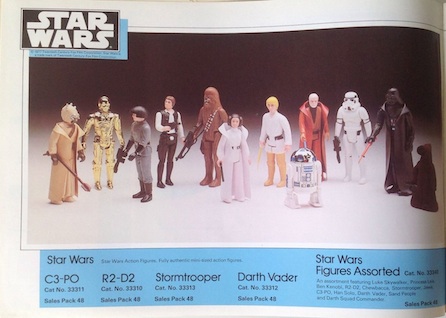 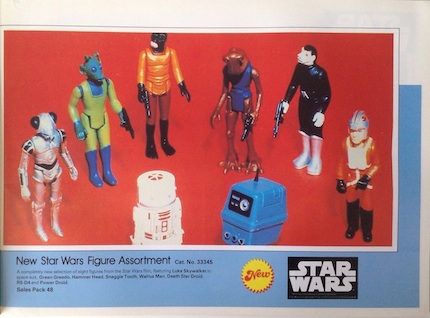 On
the third page featuring Star Wars is the Land of the Jawas playset
which is the Kenner version with the escape pod. The Imperial Troop
Transporter is next to this and features a rocker attachment on the back
of the vehicle that is not seen on the finished Palitoy or Kenner
vehicle. The fourth page shows the Darth Vader Tie Fighter, with the
Landspeeder and X-Wing Fighter next to it. The fifth page shows the
cardboard Palitoy Death Star with Kenner versions of the Cantina and
Droid Factory next to it. 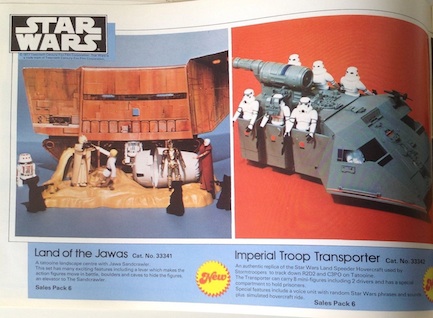  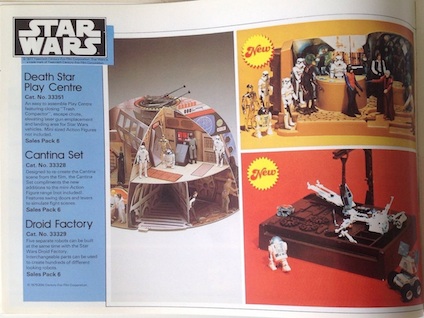 The
sixth and seventhe pages are a double spread featuring the seven Die
Cast vehicles. The eighth and last page featuring Star Wars is the Radio
Controlled R2-D2. 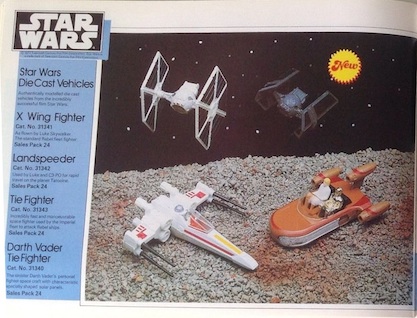   The
main catalogue for the General Sales Division has the second Diamond
Jubilee artwork featuring the same two children. This has the same
'then' photo and a 'now' photo showing them playing with a playset set
with Play-Doh. The Price List has the same artwork and is narrower than
the main catalogue. 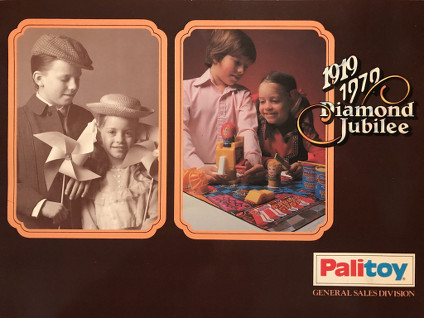 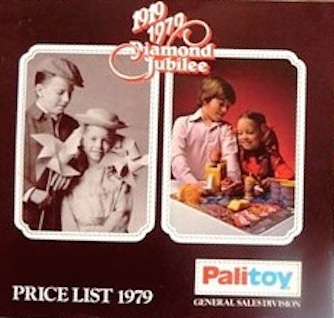 The
first page featuring Star Wars has one of the pictures from Star Wars
Playnts Painting set that came with 4 pots of non-spill Playnts paints.
The second page featuring Star Wars has the Star 3-D Poster Art set. It
came with coloured pens to colour in various scenes. It also had a 3D
Darth Vader mask.   The
third page featuring Star Wars is the photograph for the Toys section,
which has a Stormtrooper mask and the Star Wars Blaster Pistol and Laser
Rifle on it. The fourth page featuring Star Wars has the Star Wars
masks on them in a shop display retail box. There were 5 of these masks;
Darth Vader, C3PO, Stormtrooper, Sand People and Chewbacca. This page
also features the Star Wars Blaster Pistol also known as Han's Blaster
and the 3 position Star Wars Laser Rifle used by Stormtroopers. 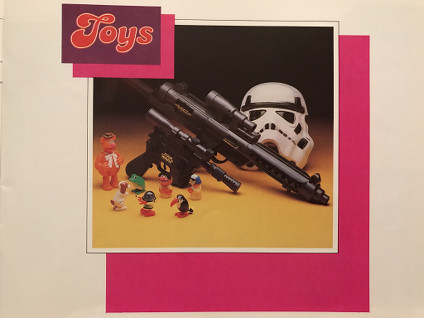  The
fifth page featuring Star Wars is the photograph for the Talking Toys
section, with the Talking R2-D2 on it. The sixth page featuring Star
Wars is the Talking R2-D2 which featured 4 different phrases. 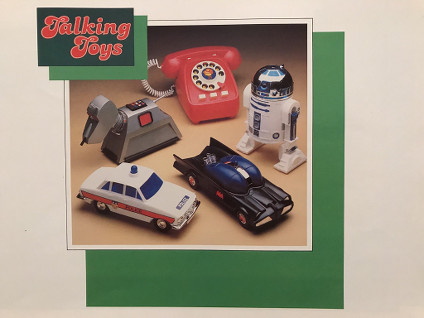 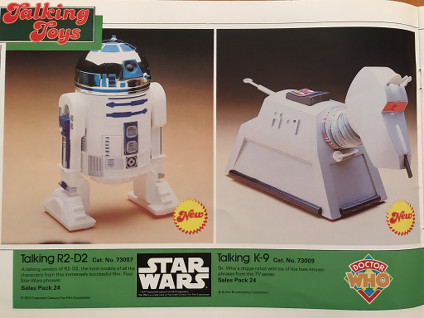 The
seventh page featuring Star Wars is the photograph for the Games
section, which has the Adventures of R2-D2 board game on it. 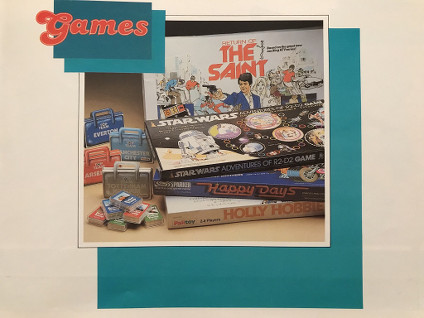 The
eighth page featuring Star Wars is the Adventures of R2-D2 board game.
This game came with 4 playing pieces and a spinner to move the pieces
around the board. The ninth and final page featuring Star Wars is the
Escape from the Death Star board game. This game also featured playing
pieces and a spinner with he extra addition of playing cards that
featured as part of the game. 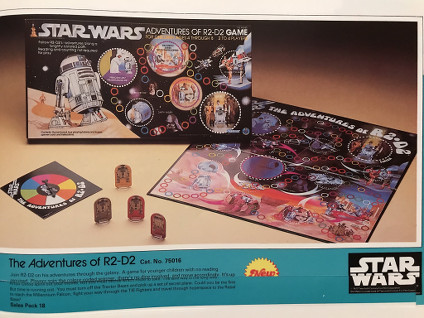  The
third Diamond Jubilee artwork features on the cover of a brochure
detailing the company history of Palitoy. The 'then' photo of the two
children is a slightly different pose and the 'now' photo is the playset
with Play-Doh taken at a different angle with the boy holding an action
man. The shown page has some history on Alfred Edward Pallett who
founded the company. A complete copy of the brochure can be seen on the
SW History page.   1979
also saw the release of a small catalogue featuring all the toys in the
Palitoy range that was aimed at consumers and was included in the Death
Star playset. The cover feature the same child in red sweater playing
with the Death Star playset that featured on the box of the playset. The
back cover featured copyright information. The first couple of pages
showed all the figures in the first wave of 12 figures and second wave
of 8 figures. 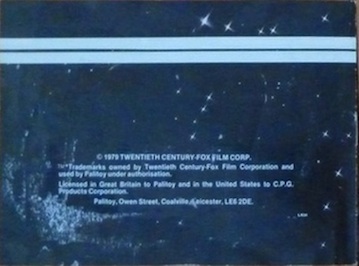  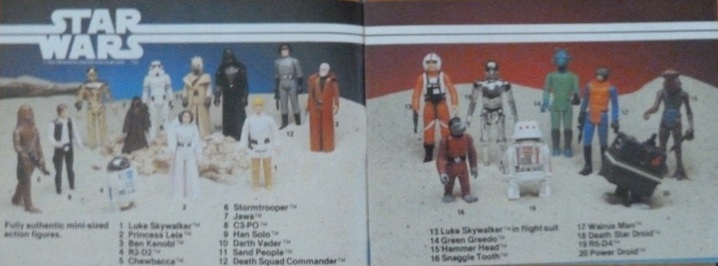 The
second couple of pages showed the Land Speeder and X-wing Fighter, next
to the Cantina and Death Star. The third couple of pages showed Darth
Vader Tie Fighter with the Escape from the Death Star and Adventures of
R2-D2 board games underneath this. Next to this is the Droid Factory
with the Land of the Jawas underneath. All toys featured are the correct
Palitoy versions. 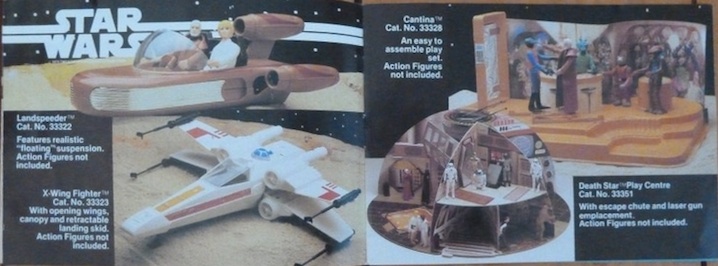  The
fourth couple of pages has the Laser Rifle, Blaster Pistol and Radio
Controlled R2-D2 with the Star Wars Diecasts on the opposite page. The
fifth and last couple of pages show 3-D Poster Art, 5 Star Wars Masks
and the Play-Doh Adventure Modelling Set opposite this. 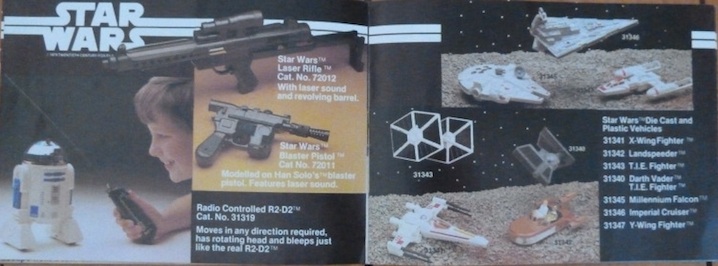 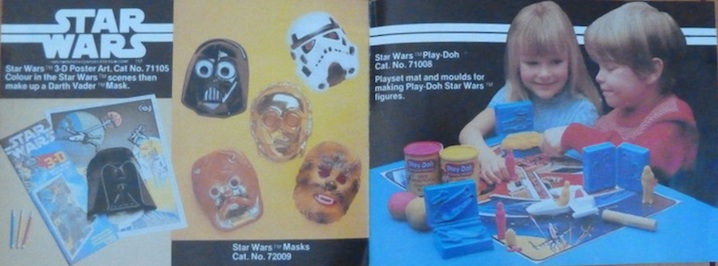 This
catalogue was reproduced in the mid 90's by Area 51 Magazine. The back
cover has extra text above the standard copyright text. The original is
shown on the left, with the reproduction show on the right.
Reproductions are generally in mint condition. You should always check
the back cover before buying one of these if you are looking for an
original!  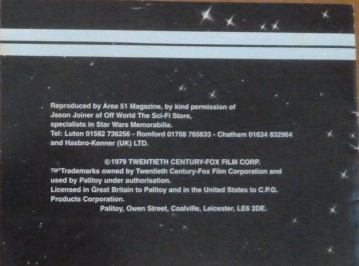 |
||
